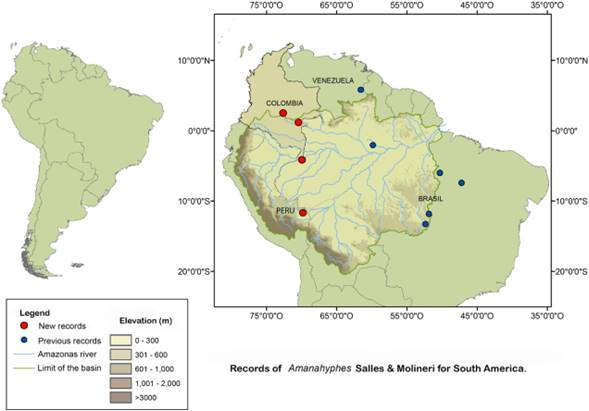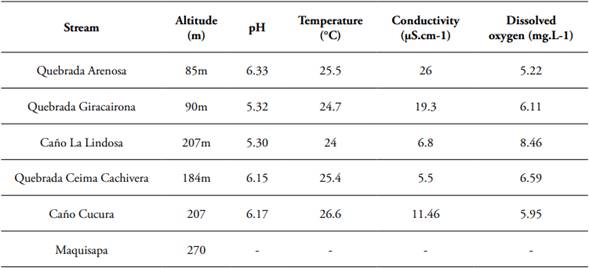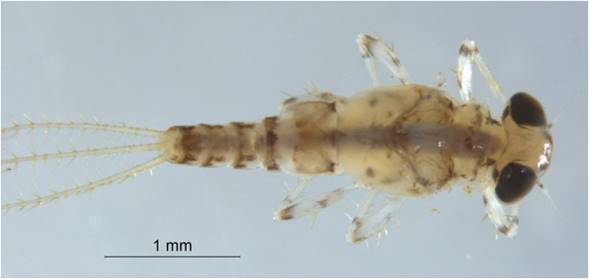Introduction
The genus Amanahyphes Salles & Molineri was originally described in Manaus, Amazonas state of Brazil, based on type species A. saguassu Salles & Molineri 2006. Later, the distribution of this species was extended to the Brazilian states of Pará, Maranhão, Mato Grosso and Amapá, as well as Bolivar in Venezuela (Belmont et al., 2012, 2015; Cruz et al., 2011; Gonçalves & Da-Silva, 2010; Molineri et al., 2011; Salles & Molineri, 2006; Shimano et al., 2010). Recently, Molineri et al. (2015) described A. bahiensis in Bahia, a Brazilian state. Thus far, the genus is known to be made up of these two species.
The characteristics that distinguish Amanahyphes from all other genera of the Leptohyphidae regarding the male adult are: eyes enlarged and divided into two portions, elongated wings, two segmented forceps arising from posterolateral projections of the styliger plate, and penis with small spines subdistally located on the lateral margin. The nymphs of the genus possess long and slender legs with claws showing two sets of denticles (a marginal row basally and a double submarginal row subdistally), and an atypical shape of operculate gills, proximally narrower, and with an inner margin nearly reaching the midline of the body distally (Salles & Molineri, 2006; Molineri et al., 2015).
In order to increase the knowledge about the Ephemeroptera in Colombia, the following collections were revised: Colección de macroinvertebrados acuáticos de la Amazonia colombiana (COMAC), located at the Instituto de Investigaciones Amazónicas - Sinchi (Leticia) and Colección Entomológica del Programa de Biología de la Universidad de Caldas (CEBUC), Manizales.
Methods
The material of Ephemeroptera of the COMAC and CEBUC Collections was reviewed with stereomicroscopy along with the Peruvian material from the StroudFAMU Peru Expedition (Sweeney et al. 2020), collected by Wills Flowers. Later, buccal parts and legs of some individuals were mounted for revision in a microscope. Pictures were taken using a Leica M205C stereomicroscope with an attached Leica MC-170HD camera.
For this study, an additional sampling was done in the following streams: Arenosa (located in the municipality of Leticia), Ceima Cachivera and Cucura Cachivera (located in the municipality of Mitú). A distribution map of the genus was drawn considering the locations where the genus was previously registered and the new records (Fig. 1).
The following environmental parameters were measured at each site (Table 1): altitude, acidity (pH), temperature (°C), conductivity (µS.cm-1) and dissolved oxygen (mg.L-1).
Results
A total of 13 nymphs of Amanahyphes (Fig. 2) were revised. This is the first record of the genus from Colombia and Perú and the range of distribution was expanded for the Colombian Amazon in the departments of Amazonas, Guaviare and Vaupés and the Peruvian Amazon in the Madre de Dios department (Fig. 1). The available environmental parameters of streams sampled in Colombia are shown in Table 1.
Material examined: Colombia, Amazonas, Leticia: 4 nymphs, La Arenosa stream, 4°07’51.4”S, 69°57’13.7” W, 27/IX/14, Dias, LG; Laython, M and Candre, A (CEBUC). 2 nymphs, Giracairoma stream, 4°06’0.6” S, 69°55’29.4” W, 28/IX/14, idem (CEBUC). Colombia, Guaviare: 1 nymph, Caño La Lindosa, 2°30’24.5” N, 72°38’28.4” W (COMAC). Colombia, Vaupes, Mitú: 2 nymphs, Cucura Cachivera, 1° 09’ 39.36” N, 70° 08’ 49.05” W, 03/III/2018 Dias, LG; Bacca, T. and Toro, B. (CEBUC). 4 nymphs, Ceima Cachivera, 1° 13’ 23.16” N, 70° 09’ 43.68” W, 28/II/2018, Dias, LG; Bacca, T. and. Toro, B. (CEBUC). Perú, Madre de Dios: 1 nymph, Centro de Investigación y Capacitación Río Los Amigos (CICRA), Maquisapa stream, 12°32’05.3” S, 70°07’08.0” W, 23/VIII/2006, Flowers, RW; Funk, D; Sweeney, B.
Discussion
The individuals found in this study belong to the species A. saguassu and have the characteristics described by Salles & Molineri (2006). We found some variation in the number of marginal denticles of the hind legs (6-8 marginal denticles), in relation to the original description of the species, where they found 4-6 marginal denticles.
The environmental parameters found in the sampled streams where this species lives are characteristic of Amazonian rivers: pH, dissolved oxygen and conductivity relatively low, and high temperature (Pascoaloto, 2001).
This new records highlight the importance of conducting new research studies of aquatic insects in the different Amazonian departments of Colombia and Perú, which are still largely unexplored.

















